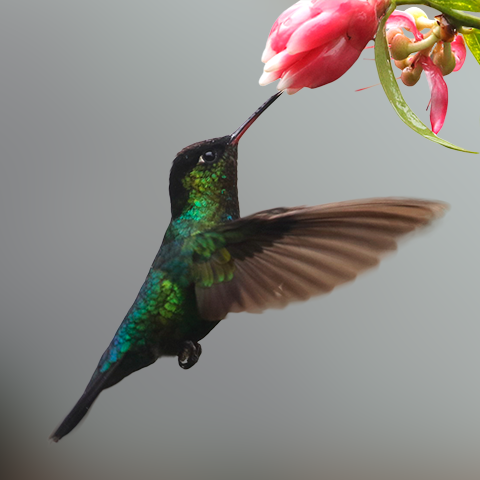


Panterpe insignis (Fiery-throated hummingbird) is one of the smallest birds on our planet. They naturally occur in the beautiful mountains of Costa Rica and West Panama. You will only find these hummingbird species at an elevation of 4,500 feet and above.
However, they also visit woodland clearings and edges sometimes. So, if you are looking to learn about this hummingbird species, you have come to the right place. Here is what you must know about these species.

The appearance of the fiery-throated hummingbird is highly unique. It weighs over five grams and is 11 cm in length. These hummingbirds have dusky-colored feet and a straight black bill that is long.
The body plumage of the fiery-throated hummingbird is an iridescent green, which looks highly vibrant in the sunlight. Besides that, it has a white spot behind each eye and a dark blue tail. The crown of the species is a brilliant blue crown.
However, the sides and back of the head are velvet black, and it has blue patches on its chest. The throat of the hummingbird is also a copper orange, hence the name. You will notice that the females and males of this species look highly alike.
On the other hand, the immature birds of this species will have rufous-colored fringes on their head and feathers. The colors of this hummingbird are bright and fiery. You can spot them from far if you have the right equipment.
Apart from breeding, hummingbirds like their solitude. You will notice this breed alone unless they are mating. That is because they don't migrate or live in large flocks, and they don't have a pair bond.
The pattern of mating is interesting among these birds. The male hummingbirds will try to court the female birds by flying in a u-shape pattern in front of them. The brighter the colors of the feathers are of the male, the more the female will be attracted towards him.
Once the female hummingbird chooses who to mate with, the make will copulate with her. However, after the copulation, the male will separate and probably never contact the female hummingbird again. The male will also mate with various female hummingbirds during their lifetime.
Besides that, the male Fiery-throated hummingbird will not participate in selecting the best location, building it, or raising the tiny hummingbirds. The role of the make ends at mating with the female.
The role of the female hummingbird is essential. They are responsible for building a nest for their chicks out of plant fibers woven together. The females also use green moss on the outside to ensure camouflage so the chicks can stay protected.
The location of the chick's nest will also be at a high location safe from other predators. For example, most female Fiery-throated hummingbirds will keep their nest two to four meters high at the end of a bamboo stem. They line the nest with plant fibers, feather down, and animal hair.
Doing all of this helps the females strengthen the structure by adding sticky materials or spider webs to offer an elastic quality to the nest. It helps the nest grow in size, so the baby hummingbirds have more room to grow in peace.
An average clutch of the fiery-throated hummingbird will have two white eggs. The eggs are quite small and will be the size of a coffee bean. The female is alone during this process, and she broods the eggs for fifteen to nineteen days.

During this brooding period, the male hummingbird will continue to defend the territory and the flower he uses to feed on. On the other hand, the female protects and feeds the chicks with things such as insects. That is because the flower nectar is an insufficient protein source for the chicks.
The young are left alone after a maximum of nineteen days. After that, the baby Fiery-throated hummingbird will leave the nest when they are more than twenty days old. No chick stays more than twenty-six days in the nest.

The diet of the fiery-throated hummingbird is one of the most important things to understand as it is unique. These birds' main source of nutrition is the nectar they take from various bright flowers, shrubs, trees, herbs, and much more. The hummingbirds mostly take nectar from flowers that offer a high sugar content.